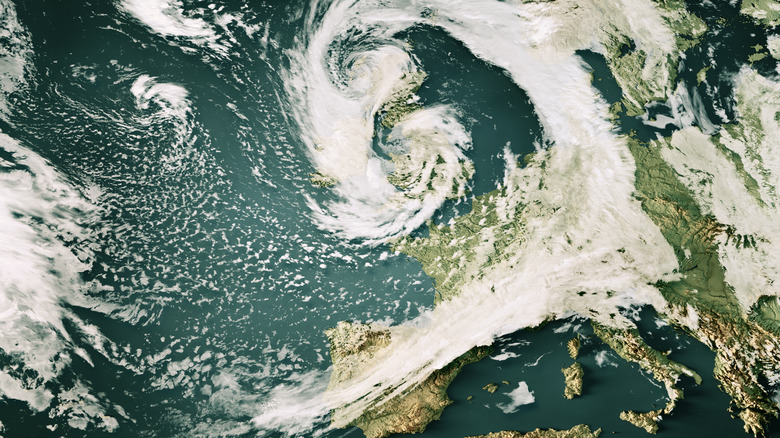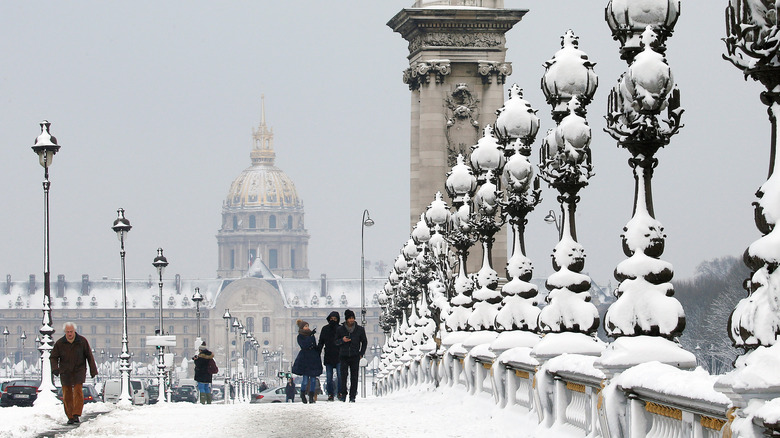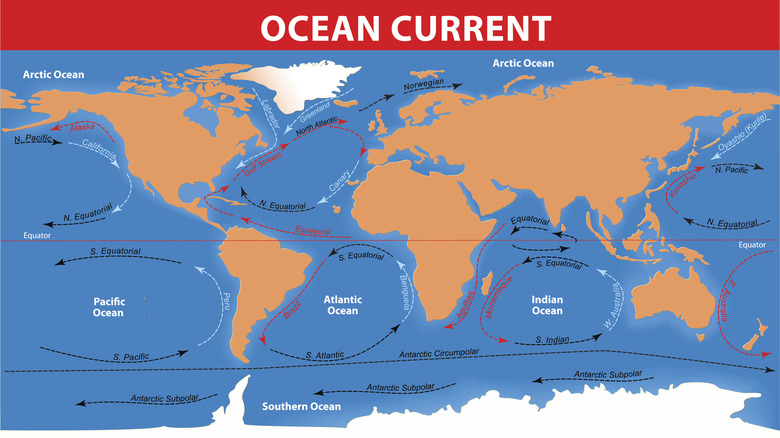This Is What Would Happen To Earth If The Ocean Currents Collapsed
New research published in the Nature Communications science journal in 2023 warns that the Earth's delicate climate system is in dire peril. Researchers predict that as early as 2025, meltwater created by climate change could disrupt the ocean's currents so much that they cease to function properly. The paper makes the gloomy prognosis that there is a 95% chance we will go through this dangerous transitional period sometime between 2025 and 2095.
The Atlantic Meridional Overturning Circulation — or AMOC — is the ocean conveyer that moves warm water from the tropics to the North Atlantic. As the warm water moves it gradually sinks as it cools, and the whole cycle begins again — creating a pleasant regulatory loop that greatly benefits human beings. You may have heard of the Gulf Stream, which is part of this watery network and creates a more temperate climate in Europe, for instance.
But what happens when AMOC runs amok? A sudden influx of freshwater from Greenland will inevitably stop the salt water from sinking as it usually does, causing havoc in the cycle. People living in Europe and the U.S. are likely to experience extremely unpleasant changes to their environment in addition to enormous sea level rises that could submerge East Coast cities like New York and Boston. Those not sweating it out due to rising temperatures will live in a frozen hellscape and all of us will be battered by unpredictable weather.
Frozen Europe
While you may associate climate change with increased warming — this is only part of the terrifying tale. A sudden disruption of the Gulf Stream's helpful currents could cause a return to ice-age-like conditions in the world's already chilly North.
You may remember this effect occurring in the silly but entertaining disaster flick "The Day After Tomorrow," albeit in the film it happens way too quickly and in a sensationalized fashion. Still, sudden drastic changes could potentially happen quite quickly; when AMOC was last disrupted — during the last Ice Age — temperatures changed by 10 to 15 degrees in just 10 years (via CNN).
Europe is likely to be particularly severely affected because, in truth, the continent should be much colder than it is given its latitude. It is only the ocean currents that prevent Europe from being enveloped by icy cold conditions. The U.K., for example, is parallel with Northern Canada but doesn't get particularly cold. In the worst-case scenario, the sea ice that currently blankets the Arctic would become a common sight much further south. Speaking to Vice magazine, climate scientist Peter Ditlevsen remarked "We would probably get a climate in Western Europe more like the climate in Alaska." In the tropics, on the other hand, temperatures would continue to soar.
The great rainfall shift
The world's weather systems will also be drastically affected by any change to the AMOC cycle. Cutting off the ocean's currents will alter rainfall patterns across the world and change how tropical monsoons behave. According to some estimates, the drop-off in rainfall could potentially lead to mass starvation across Africa and Asia as crops begin to fail.
USA Today reports that the U.S. is also likely to be severely affected by the shifting weather patterns. In the Western and Central U.S., there is likely to be a fall-off in seasonal rains and a high likelihood of drought. On the East Coast, on the other hand, violent hurricanes are likely to become more common, disrupting lives and causing untold damage.
Perhaps the soundest prediction is unpredictability — we should expect more wild weather and climate extremes unless climate change can be halted and reversed in the near future. Destroying the delicate balance in the world's weather systems is likely to have terrible consequences, both seen and unseen.


